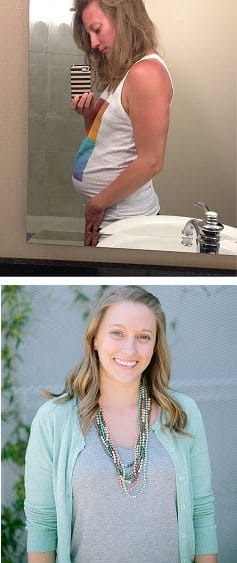 April Marlow-Ravelli (Top) showing effects of glutening at only one month pregnant. (Bottom): April two months later.
April Marlow-Ravelli (Top) showing effects of glutening at only one month pregnant. (Bottom): April two months later. For celiac patients, getting glutened is surprisingly common. Read all about it in this article from the Allergic Living archives.
She looked down at her stomach in shock and disbelief. While April Marlow-Ravelli was one month pregnant, her belly was suddenly protruding as if she was six months along. Round and hard, her stomach was also in so much pain that she was having trouble breathing.
With this gut-wrenching discomfort, she knew exactly what had happened. “I’ve been glutened!” Marlow-Ravelli thought.
Earlier that day in May 2014, the fit 31-year-old had run the first five-kilometer leg in a relay marathon in Burlington, Vermont and then stayed to cheer on her teammates. By 1 p.m., she was starving and, once served at a local restaurant, she inhaled a salad and piece of salmon.
A resident of Durham, North Carolina, Marlow-Ravelli was diagnosed with celiac disease seven years ago, and has been careful ever since to avoid food with wheat, barley and rye – the gluten containing grains that for years had caused her migraines, bloating and diarrhea. In restaurants, she always explains her condition and asks servers a lot of menu questions.
That Sunday afternoon was no different, and the waiter had seemed well-informed. “You can’t have the chicken because it has a marinade, but you can have the salmon, no problem,” he assured. Except – he was wrong.
It wasn’t the first time Marlow-Ravelli has been glutened, and she knows it won’t be the last. Aside from the physical smackdown, there is the disquieting knowledge that no matter how hard she tries, she cannot seem to steer clear enough of gluten to heal the damage it has done to her small intestine.
With Celiac, Up to 70% Glutened
Study findings bolster what Marlow-Ravelli’s gut, quite literally, has been telling her. During the 2014 Digestive Disease Week conference, Dr. Joseph Murray of the Mayo Clinic presented promising results with 342 celiac patients participating in a clinical trial of larazotide acetate, a drug being evaluated as a support to the gluten-free diet for treating celiac disease. [Update July 2022: The Phase 3 trial with this drug was discontinued due to disappointing interim results.]
The bow-tied gastroenterologist also referenced research that shows an astonishing level of recurring symptoms in celiac patients on the gluten-free diet. “Up to 70 percent of individuals report being exposed to gluten deliberately or inadvertently, which causes not only GI-related symptoms, but also headache and tiredness,” Murray told conference-goers.
He and colleagues presented a poster about another study, which looked at symptoms and inflammation in patients with celiac disease. It found that 65 percent of participants had a level of intestinal damage consistent with untreated celiac disease, despite their attempts to follow a gluten-free diet.
While those with the condition express concern about persistent intestinal damage and whether it leaves them susceptible to serious diseases, such as lymphoma, from his Minnesota office, Murray adds this note of comfort: there is a big difference between “healing” and “being healed”. One Finnish study, in fact, concluded the latter may take up to nine years.
“Celiac disease heals from the bottom up and when I take a biopsy, I’m only taking a sample from the top six or eight inches,” he says. “Consider that there is about 20 feet of intestine coiled in the body and it’s easy to understand. That’s a lot of intestine that has to get better before we can call it healed.”
In celiac disease, the immune system attacks the lining of the small intestine when it detects the presence of gluten. This leads to symptoms such as diarrhea, bloating, fatigue or even brain fog. In the person with undiagnosed celiac disease, the hair-like villi in the small intestine become damaged over time, and key nutrients won’t be absorbed. The longer term consequences can be a host of disparate conditions, from osteoporosis to infertility, and even cancer.
Healing the Gut: Longer in Adults
To manage the condition and your gluten-free diet, Murray thinks a key is to be closely monitored for at least the first few years, and to be honest with your physician. If you’ve consumed something with gluten, say so, not just what you think the doctor wants to hear. “I suspect some patients may not be telling the whole story about gluten exposure. They are likely getting some, at least intermittently,” he says.
Dining Gluten-Free: Tips and Where Gluten Can Hide
In past, there was only limited data on glutening based on results from child patients. Dr. Daniel Leffler, a gastroenterologist at the Beth Israel Deaconess Medical Center and Harvard Medical School in Boston, makes an important observation on this: children heal more quickly than adults. Think of that bruise your child got the other day, which has disappeared by now. Yet the one you developed a month ago is still slowly fading.
“It works the same way with celiac disease,” Leffler says. “There is a very strong correlation between older age of diagnosis and persistent damage on your biopsies.”
He counsels celiac patients to be, well, patient – given the tools at his disposal today, his focus is to help them feel better. He knows there is no such a thing as a perfect gluten-free diet, so regular bloodwork is important, as is keeping abreast of research.
“Gluten exposure is part of the reason for not healing but it isn’t the whole reason. This is a cause for concern and we need to learn more,” he says. “That said, the data are a little mixed but the best suggest the lifespan is not all that different between patients with persistent intestinal damage and those who heal.”
Celiac: Common to Get Glutened
 Leslie Morrison with her children, Stella and Keith Baigent. Morrison estimates she gets glutened about once every three weeks.
Leslie Morrison with her children, Stella and Keith Baigent. Morrison estimates she gets glutened about once every three weeks. Those who live with celiac disease know how easy it is to be glutened. Canadian Leslie Morrison was shocked to be diagnosed with the chronic disease a few years ago, although it did explain the years of bloating and fatigue. But adhering to the gluten-free diet has proved a journey of trial and error as she juggles work as a researcher for an investigative TV news program and being a parent of two kids.
For days when she doesn’t have time to prepare her own lunch before heading to work in downtown Toronto, she has scouted out restaurants with gluten-free menus. One even trumpets itself as “wheatless and meatless.” Still, Morrison figures she is being glutened about once every three weeks – including one episode after trying the so-called wheatless, meatless place.
“I’m a researcher and every time I get glutened, I go looking for answers. It messes with your head, trying to figure out where you went wrong when. In the end, I’m not sure you can pinpoint it.”
She’s often left to wonder: Was it a few errant crumbs? Was it something her kids brought home? A chef who was careless with her order? Worse, what kind of damage is this doing to her body?
These sentiments are echoed by others with celiac disease. In 2014, the nonprofit Beyond Celiac asked its Facebook followers a simple question. “Do they know when they’ve been glutened?” The question prompted about 350 responses, all saying ‘Yes!’ Commenters spoke of emotions from anger to powerlessness and fear. The symptoms described ranged from bloat to brain fog or, as one Washington state woman put it: “I get stupid.”
Avoiding Glutening: Effort, Education
 Alice Bast, President of Beyond Celiac.
Alice Bast, President of Beyond Celiac. Times are changing for celiac disease. Before Alice Bast was diagnosed more than two decades ago, she saw 22 doctors who dismissed her symptoms, which included migraines, reproductive problems, diarrhea, joint pain and relentless fatigue. When the president of Beyond Celiac founded the organization in 2003, her main concern was to raise the condition’s profile and get people properly diagnosed.
Eleven years later, it’s time for the message to change. Now, the organization must ensure the general public understands that going without gluten is the only treatment for the condition. To that end, Beyond Celiac has a training program for food-service establishments (called GREAT Kitchens). Its aim is to ensure that the proper safety procedures are in place, and the chance of glutening mistakes are hugely reduced.
The learning curve for the food-service industry is complicated by the fad dieters who have embraced the gluten-free diet as their own. Marlow-Ravelli sometimes feels her wellbeing is being compromised by the anti-gluten bandwagon. When you become yet another of a legion of diners requesting that food be prepared gluten-free, staff may not understand. It takes effort to explain that, for you, this is not simply a preference.
Even Bast still encounters firsthand evidence of the scale of the awareness task. For instance, she recalls meeing a well-known chef at a fundraising event. He mentioned doing a gluten-free cooking segment on The Food Channel, yet wasn’t informed about celiac disease.
Bast took this as an education opportunity, explaining the symptoms she’d suffered every day before being diagnosed with the disease, of her stillborn child and two miscarriages. The chef was shocked. “I didn’t know that a gluten-free diet was connected to a disease,” he said. Now, he does.
Bast feels it’s important to get across the message that, with celiac disease, eating gluten-free is not a choice but a health necessity. Ask lots of questions when you’re dining out. Don’t be shy and have the courage to say ‘no thanks,” and walk out of a restaurant if you aren’t happy with what you’re told or how you’re treated.
“People need to speak up and if they get glutened, they need to complain. Restaurants track complaints and they act on them,” she says. For the person with celiac disease, “avoiding gluten is the equivalent of a diabetic having to take insulin,” she says. “While we have hope for a future with additional medication, it’s our only medicine right now.”
While she drives home that message, researchers like Murray are working hard in anticipation of a day, sooner rather than later, that the diet will not be the only answer.
“I have a ragweed allergy and I could move to Alaska, Ireland or Hawaii where I likely would not need any medications. But as well as trying to avoid the pollen, I also take medications that lessen the effects it has on me,” says Murray. “People with celiac disease shouldn’t be any different. They should have therapeutic options.”
Back in Durham, Marlow-Ravelli’s pregnancy was starting to show for real late in the summer of 2014 – and while eating for two, she was taking even greater care. Although she has missed the foods she’s had to give up, especially Krispy Kreme donuts fresh from the oven, she knows those days are behind her. Still, she dreams of a future where, if she unwittingly ingests gluten, she will be able to take a pill to neutralize its effects.
“I think about it so much that I can hardly wait,” she says. “But I will.”
Related Reading:
What to Do If You’ve Been Glutened





